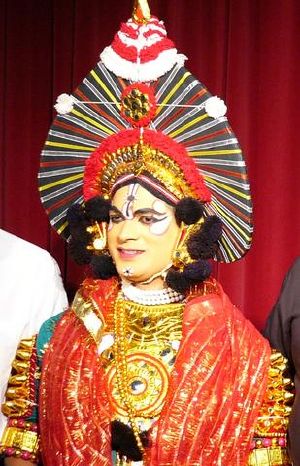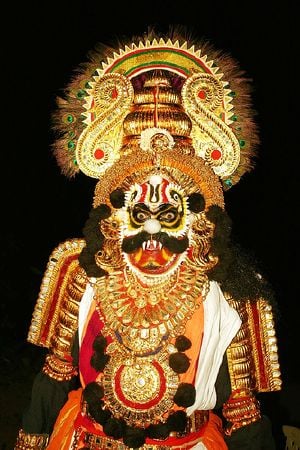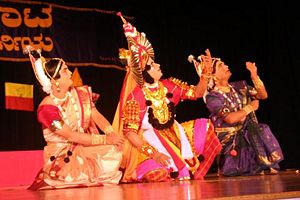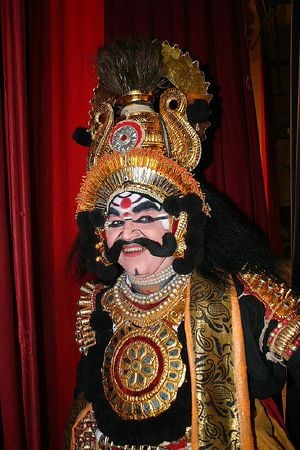Difference between revisions of "Yakshagana" - New World Encyclopedia
MaedaMartha (talk | contribs) (New page: [[Image:FullPagadeYakshagana.jpg|right|thumb|A Yakshagana artist wearing ''pagaDe'' or ''kedage mandala'', one type of ''headwear''. Among the headwears, ''pagaDe'' and ''kireeTa'' are wor...) |
MaedaMartha (talk | contribs) |
||
| Line 119: | Line 119: | ||
| − | {{credits|Yakshagana|254656349|}} | + | {{credits|Yakshagana|254656349|Bhakti_movement|254071116|Madhalam|248611234|Yakshagan_Tala|254656109|Yakshagana_Poetry|254656169|Muddana|247354382|Idagunji_Mahaganapathi_Yakshagana_Mandali|245192306|Yakshagana_Poetry|254656169|Yakshagana_Raga|254656017|Gamak|248794924|Bhairavi_(music)|246661069|Bhairavi_(ragam)|253436462|Green_room|247164571|}} |
Revision as of 20:45, 29 November 2008
Yakshagana (Kannada:ಯಕ್ಷಗಾನ, pronounced as yaksha-gaana) is a dance drama popular in the state of Karnataka. It is believed to have evolved from pre classical music form and theatrical arts [1]. Yakshagana is popular in the districts of Uttara Kannada, Shimoga, Udupi, Dakshina Kannada and Kasaragod district of Kerala.[2] This would be considered to be a form of opera in western eyes. Actors wear costumes and enact the various roles. Traditionally, Yakshaganas would go on all night. It is sometimes simply called as Aataā in both Kannada and Tulu (meaning play).[2] Yaksha-gana literally means the song (gana) of a Yaksha. Yakshas were an exotic tribe mentioned in the Sanskrit literature of ancient India.[3]
Yakshagana consists of a Himmela (background musicians) and a Mummela (dance and dialog group) which together perform a Yakshaga Prasanga. Himmela consisting of Bhagawata who is also the facilitator (singer), Maddale, Hormonium for drone and Chande (loud drums). The music is based on pre-Karnataka Sangeetha Ragas characterised by melodic patterns called Mattu and Yakshagana Talas. Yakshagana Talas are believed to be based on the groves which later have evolved in to Karnataka Sangeetha Talas. The both Yakshagana Raga and Yakshagana Tala have some folk influence. A Yakshagana performance begins at the twilight hours with the beating of several fixed compositions on drums called Abbara or Peetike, for up to an hour before the 'actors' get on the stage. The actors wear resplendent costumes, head-dresses, and painted faces which they paint themselves. A performance usually depicts a story from the Hindu epics and puranas. It consists of a narrator(Baghawatha) who either narrates the story by singing or sings precomposed dialogs of a character, backed by musicians playing on traditional musical instruments as the actors dance to the music, with actions that portray the story as it is being narrated. All the components of Yakshagana, music, dance and dialog are improvised. Depending on the ability and scholarship of the actors variation in dance and amount of dialog may change. It is not uncommon for actors to get into philosophical debates or arguments without going out of the framework of the character being enacted.
The Word and the World
Yakshagana is a traditional theater form combining dance, music, spoken word, costume-makeup, and stage technique with a distinct style and form. ≠ Both the word Yakshagana and its world are interesting and intriguing. It is a theater form mainly prevalent in the coastal districts and adjacent areas, in Karnataka. It is closely connected with other forms prevailing in other parts of Karnataka, and its neighboring states of Andhra Pradesh, Kerala, Tamilnadu and Maharastra.[4] According to noted theater artist and writer B.V Karanth,classical dance forms like Barathanatya originated from Yakshagana Yakshagana, like many other forms, defies neat classification into categories like folk, classical, rural. It can be included into each of these, or all of them together, depending upon our line of approach. Being a theater form, unlike a dance form, it is more plural and dynamic. And hence it exhibits many types and varieties inside itself. However, Yakshagana can be rightly called a traditional form. Primarily it is a name given to the one prevailing in Coastal and Malnad areas of Karnataka, though in fringe forms like Doddata are also called by the same name often, especially recently. The traditional theater form Mudalpaya of Southern Karnataka, the Doddata of Northern Karnataka, the Kelike in the borders of Andhra Pradesh, the Ghattadakore of Kollegal in Chamarajnagar district – are such forms. Among them, the Ghattadakore is a direct branch of Coastal Yakshagana, while Mudalapaya is the most closely connected form. There is a form called Yakshaganamu in Andhra Pradesh also which exhibits resemblance to the forms of Karnataka plateau region.[5]
The Genesis
The origin of any art form is in a way difficult to fix and the time and process of formation conceived is often arbitrary. As art forms grow over a period, and they include various elements from time to time and undergo many changes until they appear as we see them today. Theater forms become solo performances (for example, Kathak) and may be vice versa.[citation needed]
The Origin
Basically Yakshagana is the product of the Vaishnava Bhakthi movement.[6] Vaishnavism as a school of thought and religion is quite old. The Bhakthi movement proper, spread with vigor after the 10th Century. It took religion to the common man, to the lower strata of society, those classes to whom the highly formalized and Vedic religion was beyond reach. Hence Bhakthi movement was a social movement also.
In order to propagate and spread the message of devotion, it adopted and adapted the existing folk as well as classical literary forms and performances. It created its own forms. Most of the traditional theater forms are the result of this phenomenon. Hence there are clear resemblance among the members of the 'Traditional Theater Family' like Ankhia Nata (Assam), Jathra (Bengal), Chau (Bihar, Bengal), Prahlada Nata (Orissa), Veedhinatakam & Chindu (Andhra), Terukoothu Bhagawathamela (Tamil Nadu), Kathakkali (Kerala). Yet there are major differences also. Yakshagana is a member of this group and so its origin is connected with a wider historical situation.[7]
Experts have placed the origin of Yakshagana from the 11th Century to the 16th Century.[7] Earliest limit is fixed by a finding by Vidwan Bannanje Govindacharya who says a legend goes to show that Sage Narahari Thirtha (c, 1300) started a Dasavathara Ata performance and a troupe in Udupi and later this spread to other places and grew into what we call Yakshagana today.
Anyway, Yakshagana must have been an established form by the time of famous Yakshagana poet Parthisubba (1600) who wrote the Ramayana in Yakshagana. Because he is said to be a Bhagawatha (singer) himself and is believed to have founded a troupe, and probably he is the formulator of the Tenkuthittu (Southern style) of the art. Troupe centers like Koodlu and Kumbla in Kasaragod District, and Amritheshwari, Kota near Kundapur claim having a troupe three to four centuries ago. So we can safely assume that this art form had taken shape by about 1500. However, what we see today as Yakshagana, must have been the result of a slow evolution, drawing its elements from ritual theater, temple arts, secular arts like Bahurupi, royal courts of the time and artists imaginations – all interwoven over period.[7]
Growth and Changes
With the socio-economic changes of the 19th Century, arts like Yakshagana also changed. The 19th Century produced a big number of compositions. Around 1800, a troupe from Dharmastala visited the court of the king of Mysore and established a troupe there. In the 1840s, a troupe from Uttara Kannada (North Kanara) visited Maharastra, and inspired the first modern age mythological drama by Vishudas Bhave. A number of troupes arose all over the Coastal Karnataka and probably in other parts of Karnataka too. By the early decades of this Century the structure of Yakshagana reached a definite shape and form.[citation needed]
1930s saw some changes in compositions, organizations and presentation. Dance and the spoken word was further developed and refined. But in costume, a type of degeneration started setting in due to the use of 'modern' clothing and stone jewellery, in place of hand loom clothing and wooden ornaments.[citation needed]
The year 1950 saw the birth of 'tent' troupes, giving performances to audience by tickets, with 'tent theaters' and furniture for seating. These troupes brought in commercialization of Yakshagana, with both merits and demerits. Yakshagana saw major changes in form and organisation, electrical lights replaced the 'gas lights' or 'petromax' lamps. Seating arrangements improved. Major changes came in the themes, with the inclusion of folk epics, Sanskrit dramas and created (imaginary) stories forming the thematic base. Popular entertainment became the criterion in place of 'classical' presentation. Tulu, the language of the Southern part of the D.K. district was introduced on the stage, where hitherto only Kannada was used. This gained great popularity. All these trends continued with added vigor after 1970s, with a new element of influence. Noted writer, Late Dr. Kota Shivaram Karanth experimented with the dance form by introducing Western musical instruments. He also reduced the time of a Yakshagana performance from 12 hours to two and half hours, for the convenience of city dwellers. Another trend that has emerged in modern Yakshagana is the incorporation of movie stories.
Yakshagana has undergone innovation in dance and theatre, which includes performances of Shakespeare.[8]
The Variations
There are two variants of Yakshagana. In this fierce competition, the two styles differentiate from one another through the instruments played, but also through the costumes displayed. [citation needed]
Badagutittu
The Badagutittu style, as its name indicates, is prevalent in Northern parts of South Canara, that is, from Padubidri to Byndoor and North Kanara District. It makes use of a typical Karnataka chande.[9] The Badagutittu style was popularized by Shivram Karanth's Yakshagana Mandira at Saligrama village in Dakshina Kannada as a shorter, more modern form of Yakshagana.[9] Keremane Shivarama Heggade, the founder of the Yakshagana troupe, Idagunji Mahaganapathi Yakshagana Mandali is an exponent of this style of Yakshagana. He is also the first Yakshagana artist to receive the Rashtrapati Award.
Tenkutittu
The second variation, the Tenkutittu style, is prevalent in Southern areas of South Canara, that is, from Mulki to Kasargod. It is accompanied by a Kerala maddalam. Another aspects that sets it closer to Kathakali than its northern counterpart is the less exuberant costumes, notable the demon ones.[9] One notable practitioner of Tenkutittu style Yakshagana was the late Sheni Gopalakrishna Bhat.[9]
The Troupes
There are about 30 full fledged professional troupes, and about 200 amateur troupes in Yakshagana. Professional troupes go on tour between November to May, giving about 180-200 shows. There are about one thousand professional artists and many more amateurs. Further there are off season shows during the wet season, the anniversary shows, school and college students Yakshagana and of course the Talamaddale performances. Yakshagana commercial shows witness 12,000 performances per year in Karnataka generating a turnover of Rs. Six crore.[10][11]
Yakshagana Puppetry
Another interesting facet of Yakshagana is the its use in puppetry. Evidence shows that there were more than 30 string puppet troupes in the undivided Dakshina Kannada district during the period 1910 – 1915 in places like Basrur, Barkur, Kokkarne, Mudabidri etc.
The puppetry in Yakshagana style is interesting as the presentation is highly stylized and adheres strictly to the norms and standards of Yakshagana. The puppets used are generally 18 inches high and the costumes are similar to those worn by the characters from Yakshagana with the same elaborate make-up, colorful head gear and heavy jewellery. The person who infuses life into the puppet and makes it come alive, by dexterous manipulation is known as the Suthradhara. The content in the Yakshagana puppetry, is drawn heavily from the ancient epics.
Background of Yakshagana Puppetry
Though Yakshagana puppetry had existed since a long time, it was moulded by Laxman, Narasimha and Manjappa Kamath, hailing from Uppinakudru village in Kundapur taluk. Devanna Padmanabha Kamath, the grandson of Laxman Kamath infused new life into it and performed shows all over India. Currently, his son Kogga Kamath is at the forefront, performing shows and training youngsters in Yakshagana puppetry.[12]
Training and Research
Training schools for Yaskhagana are very few in Coastal Karnataka. As most troupes are associated with temples, the training has been confined to the temple premises. However, the Govinda Pai Research Institute, located at MGM College, Udupi, runs a Yakshagana Kalakendra in Udupi that trains youngsters in this ancient dance form. The Govinda Pai Research Institute does research work on language, rituals and dance art forms.[13]
The known Yakshagana artists - a few are listed
Bhagawatike
late Agari srinivasa bhagavata,Maindappa rai,Ira gopala krishna bhagavata, Balipa Narayana Bhagavatharu,Kadatoka Manjunath Bhagavataru ,late Damodara mandechcha,Puttige Raghuram Holla, Tenkabail Thirumaleshwara Shastry, Dinesh ammannaya, Padyana Ganapathi Bhat,Leelavati Baipadittaya,Polya Laxminarayana shetty,Balipa Prasada bhagavata, Balipa shivashankara bhagavata ,Late Kadatoka Krishna Bhagavatharu, Late GR Kalinga Navuda, Subramanya Dhareshwara, Heranjal Gopala Ganiga, Raghavendra Mayya, H Suresh Shetty, Narayanappa Uppur, Vidhwan Ganapathi Bhat, Gopal Bhat, Jogi, Raghavendra Achari, Nelluru Narayana, Polya Laxminarayan Shetty, Narayana Shabaraya, , others...
Himmela
Krishnayaji Idagunji, Keshav Bhandari Karki, Sathyanarayan Bhandari Karki, Prabhakar Bhandari Karki, Gajanana Bhandari Holegadde, Kinneer Narayan Hegde, Dharmashale Mahableshwar Bhat , Parmeshwar Bhandari Karki, Manjunath Bhandari Karki, Rama Bhandari Karki Late Nedle Narasimha Bhat, Divana Bheema Bhat,Kudrekkodlu Rama Bhat (allrounders of tenkutittu), chipparu krishnayya Ballal,Mambady Subrahmanya Bhat, Peruvai Narayana Bhat,Padmanabha upadyaya,Harinarayana Baipadittaya,delantamajalu subrahmanya bhat,prabhakara gore,chandrashekhara konkanaaje,Adur Ganesh Rao, Kudrekodlu Ram Bhat,Shivananda Kota, Ananthapadmanabha Phatak and others
Gundabala Hanuman Temple is famous for Yakashagana Harakeyata. Almost all Badagutittu artists from Noth Kanara have learnt Yakshagana Art from this place. Here harakeyata is performed contineously for 150 days. Daily two devotees harake is served. All legends from Badagu tittu, such as Kondadakuli Ramachandra Hegade, Chittani Ramachandra Hegade, Anant Hegade Kolagi, Majunath Hegade, Murur Vishnu Bhat, to name few all are product of this place.
Mummela (Patradarigalu)
Keremane Shivaram Hegde, Keremane Mahabala Hegde, Keremane Shambhu Hegde, Chittani Ramachandra Hegde, Gode Narayan Hegde, Bhaskar Joshi, Balkur Krishna Yaji, Uppunda Nagendra Rao, Kondadakuli Ramachandra Hegade, Kannimane Ganapathi Bhat, Manki Eshwar Naik, Thombattu Vishwanath Achari, Kumble Sundar Rao, K. Govinda Bhat, Kolyuru Ramchandra Rao, Subramanya Hegade Chittani, Thirthahalli Gopala Achari, Hadinbal Sripad Hegde, Kappekere Mahadev Hegde, Prabhakar Chittani, Argodu Mohandas Shenoy, Sridhar Hegde Chapparmane, Halladi Jayaram Shetty, Nilkod Shankar Hegde, Mantapa Upadhyaya, Yalaguppa Subrahmanya, Narayan Hasyagar Kari, K P Hasyagar Karki, Chennappa Shetty Siddaktte, Vishwanath Shetty Sidakatte and Others
Tal Maddale
Sheni Gopalkrishna Bhat,deraje seetaramayya,Moodambailu gopalakrishna shastry,sunnambala vishweshwara bhat, Dr. Prabhkar Joshi,kumble sundar rao, k.govinda bhat,Jabbar Sumo,Subrahmanya bhat venur...Vasudeva Samaga, Ramadasa Samaga, Katte Parameshwar Bhat, Melukote Umakantha Bhat, Buchchan Shastri Karki, N S Bhat Baad, Mohan Hegde Kumta etc
Notes
- ↑ Prof. Sridhara Uppara. 1998.Yakshagana and Nataka Diganta publications
- ↑ 2.0 2.1 Enduring art. Online webpage of The Hindu. The Hindu. Retrieved 2007-09-06.
- ↑ yaksha. Encyclopedia Britannica. Retrieved 2007-09-06.
- ↑ The Hindu-Growing with tradition
- ↑ 3-day festival to celebrate Karanth's birth centenary. The Times of India. Retrieved 2007-09-06.
- ↑ The Hindu-A broad sweep at the art form
- ↑ 7.0 7.1 7.2 The Hindu- Focus on rural art. The Hindu. Retrieved 2007-09-06.
- ↑ Hapgood, Robert. 1983. "Macbeth distilled: A Yakshagana production in Delhi," Shakespeare Quarterly, Vol. 31, No. 3. (Autumn, 1980), pp. 439-440.
- ↑ 9.0 9.1 9.2 9.3 Narthaki.com, classical indian dance directory
- ↑ Open study-chairs for research on Yakshagana. Online webpage of The Hindu. The Hindu. Retrieved 2007-09-06.
- ↑ Traditional touch in theatre. Online webpage of The Telegraph. The Telegraph. Retrieved 2007-09-06.
- ↑ Award for achievement. Online webpage of The Hindu. The Hindu. Retrieved 2007-09-06.
- ↑ The Hindu-Yakshagana Kendra has effectively popularised the art form
ReferencesISBN links support NWE through referral fees
- Martha Bush Ashton, Yakshagana, Abhinav Publications, India; 1st edition (15 June 2003) ISBN-10: 8170170478, ISBN-13: 978-8170170471
External links
- Celebration of Celestials
- Listen to Yakshagana
- Yaksharanga Website
- Yakshakalamandalam(R)-Bangalore
- Yakshagana Site-3
- http://www.yakshaganapuppets.com/
- http://kondadakuli.tripod.com/
- http://www.flickr.com/photos/yakshagana/
Template:Culture of Tulunadu
| ||||||||||||||||||||||||||
| |||||||||||||||||||||||||||||
Credits
New World Encyclopedia writers and editors rewrote and completed the Wikipedia article in accordance with New World Encyclopedia standards. This article abides by terms of the Creative Commons CC-by-sa 3.0 License (CC-by-sa), which may be used and disseminated with proper attribution. Credit is due under the terms of this license that can reference both the New World Encyclopedia contributors and the selfless volunteer contributors of the Wikimedia Foundation. To cite this article click here for a list of acceptable citing formats.The history of earlier contributions by wikipedians is accessible to researchers here:
- Yakshagana history
- Bhakti_movement history
- Madhalam history
- Yakshagan_Tala history
- Yakshagana_Poetry history
- Muddana history
- Idagunji_Mahaganapathi_Yakshagana_Mandali history
- Yakshagana_Poetry history
- Yakshagana_Raga history
- Gamak history
- Bhairavi_(music) history
- Bhairavi_(ragam) history
- Green_room history
The history of this article since it was imported to New World Encyclopedia:
Note: Some restrictions may apply to use of individual images which are separately licensed.



